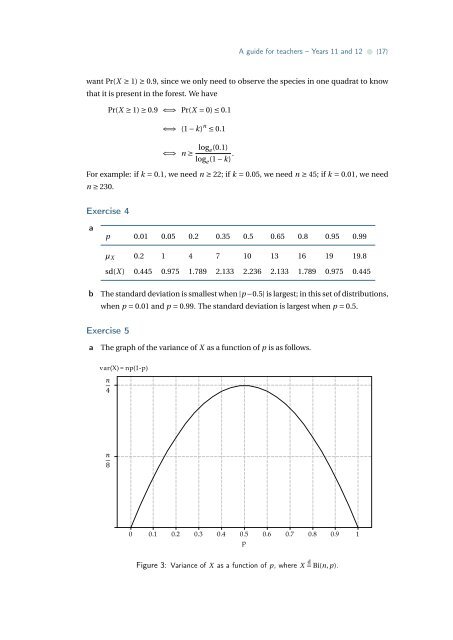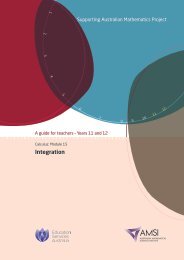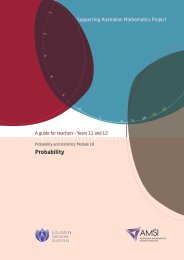Binomial distribution - the Australian Mathematical Sciences Institute
Binomial distribution - the Australian Mathematical Sciences Institute
Binomial distribution - the Australian Mathematical Sciences Institute
You also want an ePaper? Increase the reach of your titles
YUMPU automatically turns print PDFs into web optimized ePapers that Google loves.
A guide for teachers – Years 11 and 12 • {17}<br />
want Pr(X ≥ 1) ≥ 0.9, since we only need to observe <strong>the</strong> species in one quadrat to know<br />
that it is present in <strong>the</strong> forest. We have<br />
Pr(X ≥ 1) ≥ 0.9 ⇐⇒ Pr(X = 0) ≤ 0.1<br />
⇐⇒ (1 − k) n ≤ 0.1<br />
⇐⇒ n ≥ log e (0.1)<br />
log e (1 − k) .<br />
For example: if k = 0.1, we need n ≥ 22; if k = 0.05, we need n ≥ 45; if k = 0.01, we need<br />
n ≥ 230.<br />
Exercise 4<br />
a<br />
p 0.01 0.05 0.2 0.35 0.5 0.65 0.8 0.95 0.99<br />
µ X 0.2 1 4 7 10 13 16 19 19.8<br />
sd(X ) 0.445 0.975 1.789 2.133 2.236 2.133 1.789 0.975 0.445<br />
b<br />
The standard deviation is smallest when |p−0.5| is largest; in this set of <strong>distribution</strong>s,<br />
when p = 0.01 and p = 0.99. The standard deviation is largest when p = 0.5.<br />
Exercise 5<br />
a<br />
The graph of <strong>the</strong> variance of X as a function of p is as follows.<br />
var(X) = np(1‐p)<br />
<br />
4<br />
<br />
8<br />
0<br />
0.1<br />
0.2<br />
0.3<br />
0.4<br />
0.5<br />
p<br />
0.6<br />
0.7<br />
0.8<br />
0.9<br />
1<br />
Figure 3: Variance of X as a function of p, where X d = Bi(n, p).

















